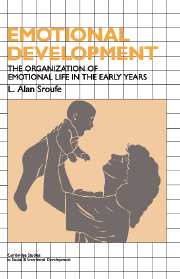Book contents
- Frontmatter
- Contents
- Preface
- Part I The nature of emotional development
- Part II The unfolding of the emotions
- Part III Emotional development and individual adaptation
- 9 The social nature of emotional development
- 10 Attachment: the dyadic regulation of emotion
- 11 The emergence of the autonomous self: caregiver-guided self-regulation
- 12 The growth of self-regulation
- 13 Summation
- References
- Index
10 - Attachment: the dyadic regulation of emotion
Published online by Cambridge University Press: 16 September 2009
- Frontmatter
- Contents
- Preface
- Part I The nature of emotional development
- Part II The unfolding of the emotions
- Part III Emotional development and individual adaptation
- 9 The social nature of emotional development
- 10 Attachment: the dyadic regulation of emotion
- 11 The emergence of the autonomous self: caregiver-guided self-regulation
- 12 The growth of self-regulation
- 13 Summation
- References
- Index
Summary
In stable environments in which mothers allow infants to move from them when the infant feels secure enough to do so and … allow infants to return to them freely, the infants are able to modulate their arousal levels.
Rosenblum (1987)The varied expectations of the accessibility and responsiveness of attachment figures that different individuals develop during the years of immaturity are tolerably accurate reflections of the experiences those individuals have actually had.
Bowlby (1973)Attachment, which refers to a special relationship between infant and caregiver that evolves over the first year of life and beyond, is inherently an emotional construct. Not only does it imply an “affective bond” between parent and infant, it also is properly characterized in terms of the regulation of infant emotion. In fact, it is the apex of dyadic emotional regulation, a culmination of all development in the first year and a harbinger of the self-regulation that is to come.
In particular, the emergence of specific attachment relationships refers to that phase in development when the infant assumes a more active role in dyadic regulation; that is, there is movement from regulation orchestrated by the caregiver to what is more truly dyadic. In the first half year, emotional regulation is accomplished through built-in regulatory capacities of the infant and a responsive caregiving environment.
- Type
- Chapter
- Information
- Emotional DevelopmentThe Organization of Emotional Life in the Early Years, pp. 172 - 191Publisher: Cambridge University PressPrint publication year: 1996
- 3
- Cited by



